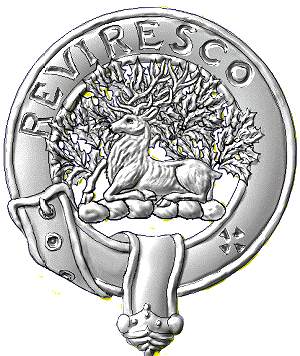
This is an introduction to the heraldry of the Maxwell family. The rules of heraldry are quite complex for the novice but if you remember that a coat of arms can only be owned by a single person at a time, then you know the most important rule of heraldry. This is not a comprehensive guide to heraldry but meant only as a taster.
Firstly, there is no such thing as a Maxwell family crest or a Maxwell family coat of arms. Any coats of arms pertaining to Maxwells that you may have seen are owned or were owned by an individual. The great majority of Maxwells do not own any arms. However if they can prove relationship to owners of arms, either living or dead, they may be able to apply a heraldic authority and obtain arms of their own. The only legal ensign most Maxwells may bear is the Belt and Buckle Badge which represents the Crest of the Chief of Maxwell surrounded by a belt with the Chief's motto upon it. This shows that the wearer has fellowship with and is a supporter of the Chief of the name, in this case, Maxwell. The badge is always in silver or plan white metal and is never represented in any other colour.
 |
Most Maxwell coats of arms have been granted or matriculated by the Lord Lyon King of Arms, the chief herald of Scotland. It is through this heraldic authority that the earliest Maxwell coats of arms came into being. The Chief of the Maxwell family started to use his distinctive armorial late in the twelfth century. The Maxwell Chief used the unique black diagonal cross on a white field. The correct heraldic term for this “Argent, a saltire Sable”. A saltire is the diagonal cross, Sable is colour black and Argent is the silver or ‘white’ field. In heraldry there is no ‘white’ or ‘yellow’. Although these colours are seen, they represent the silver and gold coloured metals, thus Argent for silver and Or for gold. The other principle colours in heraldry are; Gules: red, Azure: blue, Vert: green and Purpure: purple.
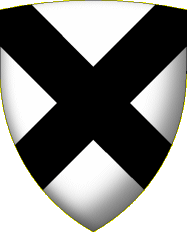 |
The arms “Argent, a saltire Sable” are unique in the armorial world to the lords Maxwell, the chiefs of the name Maxwell and date back to the very earliest period of heraldry. Within the early family, marks of cadency and differences began to appear on the arms of junior branches of the family, each forming a unique new armorial. Maxwell of Nether Pollok placed a gold ring over his black saltire and Maxwell of Calderwood surrounded his saltire with a black and white chequered border (bordure). These “differences” have persisted in these families to modern times.
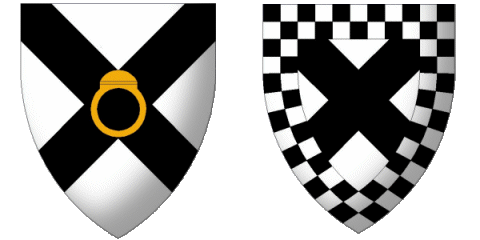 |
Arms were usually the preserve of male members of the family passing father to son as a right of inheritance. However, if there were no male children, the arms could pass through a female line to grandchildren thus preserving the old arms. When a marriage took place between armigerous persons the two coats could be “Quartered” together to make a new coat. This can be seen in the coat of John Maxwell of Calderwood who's father had married the heiress of Dennistoun of that Ilk. Thus, the arms of Janet Dennistoun's father are preserved for posterity in the arms of Maxwell of Calderwood.
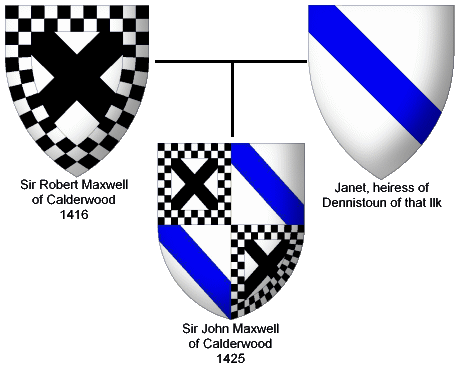 |
The lords of Maxwell bore above their arms a crest of a 'A stag couchant before a holly bush Proper'. That is to say a stag sitting in front of a holly bush. The crest is born on a wreath of his livery colours which are now black and silver (white) but were red and silver in ancient times. This crest is the one worn by loyal followers of the Chief today in their Belt and Buckle Badges. The Maxwells of Calderwood and Pollok both had Saracens heads for crests which are usually associated with crusader pasts. Most of the Irish branches of the Maxwell family had stags heads for crests as did the lords Herries and the Maxwells of Dargavel.
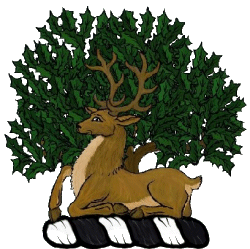 |
The motto of the ancient lords Maxwell was 'I byd ye fair' which was a greeting, however the fifth Earl of Nithsdale changed his motto to 'Reviresco' which is Latin for 'I flourish'. On Scottish armorials the motto always appears in a scroll over the top of the crest whilst on English arms it is placed below the shield. Some Scottish families carry their war-cry or slughorn (from which we get the word slogan) on a scroll beneath their arms. The slughorn of the Maxwell's is 'Wardlaw'. Some interpret this as meaning 'we are the defenders of the warden's law' after the Chief's role as Warden of the Western Marches. Another interpretation is that 'Wardlaw' is a gathering cry. On hearing the cry, Maxwell's men would rally at the top of a small hill beside Caerlaverock Castle called Wardlaw. To complete the full achievement of the ancient Lords of Maxwell, the shield is held up right by two Supporters. Supporters are usually only granted to chiefs, peers and other high ranking nobles. The lords Maxwell had two rampant stags for supporters which stood on a grassy hillock. With his helmet and the mantling flowing from it, this completes the Lord Maxwell ancient armorial.
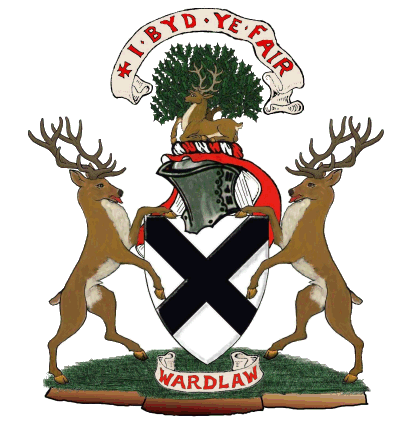 |
|
The Armorial
Achievement of the lords Maxwell of Caerlaverock to 1581
|
The armorial achievements of the Maxwell family are manyfold and diverse. I have collected over one hundred different coats, all with the exception of two are based on the black saltire of the ancient Maxwell lords of Caerlaverock. The exceptions come from the English College of Arms which obey slightly different rules in their determination of heraldic grants. In the heraldic lineage of Sir Robin Maxwell-Hyslop below you can see how the English heralds have changed the nature of the saltire in the arms of Captain Alexander Maxwell-Hyslop to differentiate between his and the Scottish arms of Maxwell of Glengabor. It is an heraldic conundrum as to why the Hyslop family should have a coat of arms based on the Maxwell crest. They may have been part of the Maxwell household in the past but when the arms were registered they were in possession of their own lands in the Stewartry of Kirkcudbright. The Bayly's of Sheepstor are a Devonshire family.
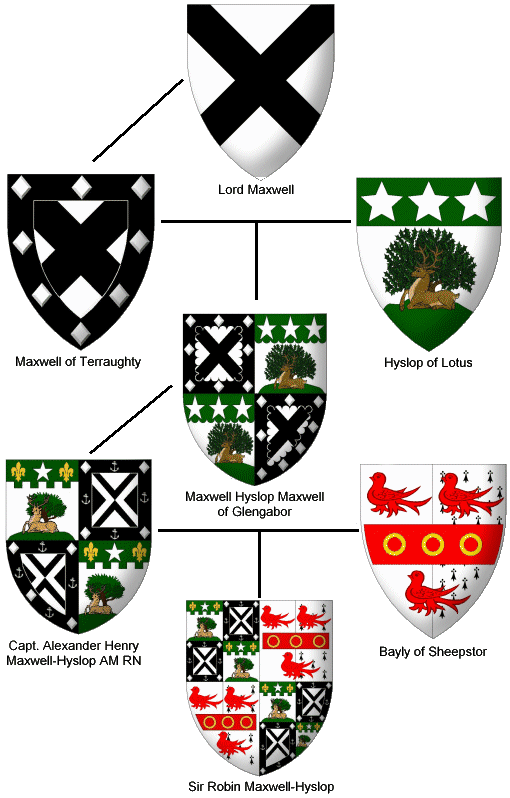 |
Below are some of my collection of Maxwell coats chosen not just for their diversity and colour but also to demonstrate the use of bordures and additional charges to difference armorial coats. If you would like to know more about the heraldry of the Maxwell family or indeed, how to acquire personal of your own, contact the webmaster. Alternatively, for a broader view of Scots heraldry, I recommend another of my websites, that of the Heraldry Society of Scotland.
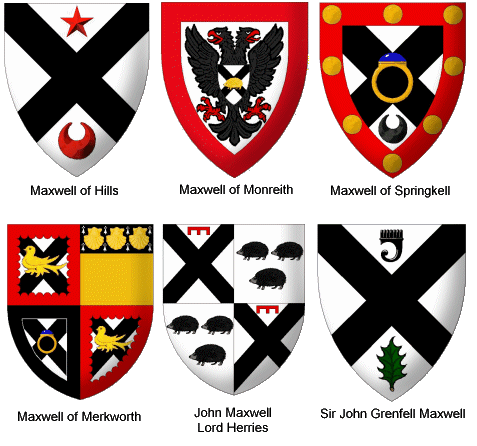
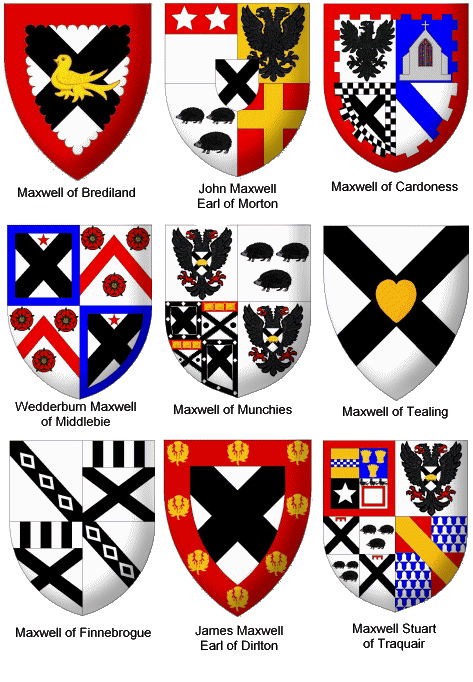
All images © Copyright 2000 George Anthony Maxwell.